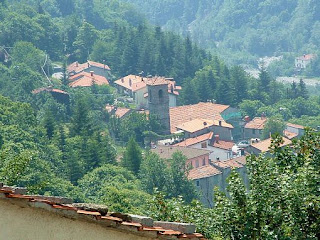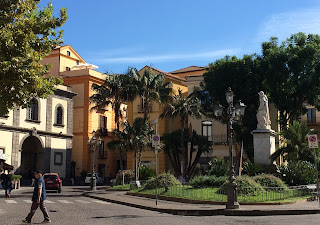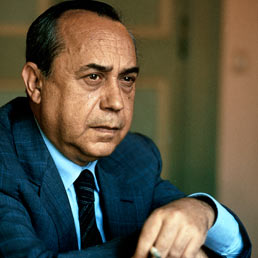One of the first Italians to write detective novels
.jpg) |
| Augusto De Angelis had many years working as a journalist |
His first detective novel, Il banchiere assassinato (The Murdered Banker), was published in 1935, six years after Italian publishers Mondadori launched their crime series in yellow covers that would later result in the word gialli being used to refer to mystery novels and films.
However, until Alessandro Varaldo's Il sette bello in 1931 there were no Italian authors on the Mondadori list to begin with, as the publishers did not see Italy as the right setting for the crime genre at that time. De Angelis did not agree with this, as he thought crime fiction was a natural product resulting from the fraught and violent times he was living in and writing about as a journalist.
De Angelis gave up studying jurisprudence to embark on a career in journalism and worked for some of the most important daily newspapers during the first half of the 20th century, such as La Stampa and La Gazzetta del Popolo in Turin, Il Resto di Carlino in Bologna and L’Ambrosiano in Milan.
He began his literary career by writing plays and non-fiction and then wrote a spy novel in 1930. But his most successful novels were his detective stories featuring Commissario Carlo De Vincenzi. To begin with, Italy's Fascist dictator Benito Mussolini approved of the crime fiction genre because it celebrated the achievements of the forces of order over evil and chaos by bringing about just solutions and restoring tranquillity. However, Mussolini and his associates eventually became wary of Italy being seen to be anything less than idyllic by the outside world.
.jpg) |
| De Angelis was among the first Italian authors in Mondadori's gialli series |
It is interesting to see how many of the traits of Commissario De Vincenzi have appeared in fictional Italian detectives since. De Vincenzi’s loyalty to his friends and care for his subordinates is a quality shown by Donna Leon’s detective, Brunetti, and his disregard for the rules, unorthodox behaviour and moments of inspiration are characteristics of both Michael Dibdin’s Zen and Andrea Camilleri’s Montalbano.
The cultured and often emotional detective, De Vincenzi, was to become very popular with the Italian public, but the Fascist government eventually came to regard his creator, De Angelis, as their enemy.
De Angelis was arrested and imprisoned by the authorities in 1943, accused of being anti-Fascist. He was released from prison after three months, but was soon tracked down by a Fascist activist to where he was staying in Bellagio. De Angelis was beaten up so badly by the thug that he died of his wounds in hospital in Como in 1944.
 |
| Pushkin Vertigo's English translation of The Murdered Banker |
He goes on to discover that Aurigi owes a lot of money , which was due to be paid that night, and that the dead body is that of the banker who lent it to him. De Vincenzi doesn’t just have to solve the crime, he has to prove his old friend is innocent of it and he has to do it quickly before the investigating magistrate becomes involved. He tells his friend that he has to tell him everything, or he could soon be facing the firing squad, but Aurigi just keeps repeating that he doesn’t know anything.
Fortunately, there are plenty of other suspects, such as Aurigi’s beautiful fiancée, his future father-in-law, Count Marchionni, and the mysterious tenant living in the apartment above. De Vincenzi is determined to get to the truth and he lays a clever trap for the murderer.
Some of the De Vincenzi novels were adapted for television by RAI in the 1970s with Paolo Stoppa playing the role of the detective. An English translation of The Murdered Banker was published by Pushkin Vertigo in 2016.
 |
| A vintage postcard showing how Milan looked in the 1930s at the time De Angelis was writing |
The Murdered Banker is set in Milan during the 1930s, where gentlemen wore evening dress when they were out at night. De Angelis would have known the city well from his time working for L’Ambrosiano. The opera house, Teatro alla Scala, which features in The Murdered Banker, was treated almost like a club and people in society visited each other in their boxes during the opera. Milan’s world- famous opera house was officially inaugurated in 1778. It replaced the Teatro Regio Ducale which had been destroyed by fire. The new theatre was built on the site of the former Church of Santa Maria alla Scala, which is how it got its name. It is situated right in the centre of Milan opposite the Galleria Vittorio Emanuele II. La Scala, as it is popularly known, has hosted premieres of operas by Rossini, Donizetti, Verdi and Puccini and the world’s finest singers have appeared on its stage.
 |
| A steep stone staircase typical of Bellagio |
Bellagio in Lombardy, where De Angelis was living just before his death, is a village on a promontory jutting out into Lake Como, at the point at which the lake divides into two legs, the more easterly of which is called Lago di Lecco. It is known for its cobbled lanes, elegant buildings, steep stone staircases, red-roofed and green-shuttered houses. The Villa Serbelloni Park, an 18th century terraced garden, offers spectacular views of the lake. The villa itself was once popular with European royalty, numbering Maximilian I of Austria and Queen Victoria of England among its guests.
Also on this day:
1503: The birth of Giovanni della Casa, 16th century author and advocate of good manners
1909: The birth of partisan Walter Audisio, who claimed to be the man who executed Mussolini
1952: The birth of Olympic sprint champion Pietro Mennea
1971: The birth of footballer Lorenzo Amoruso












